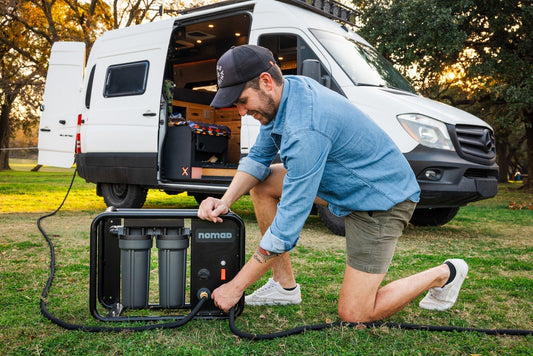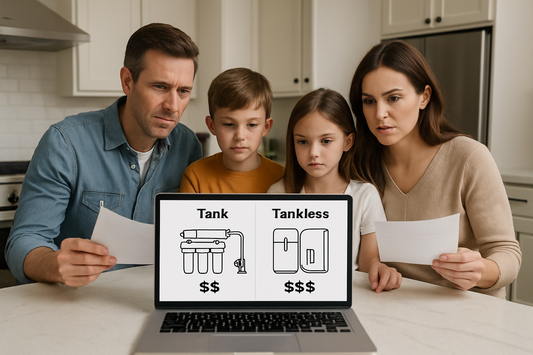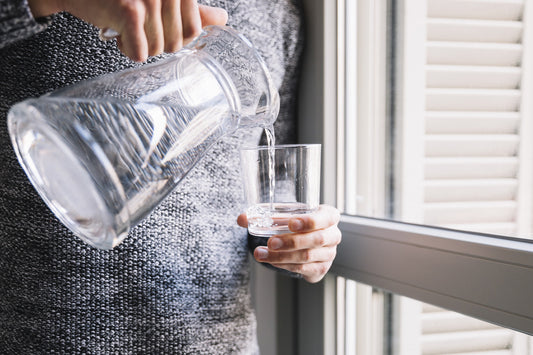For many American households, clean drinking water has become a top concern—especially as awareness grows around contaminants like lead, PFAS, chlorine, and VOCs. If you're tired of relying on bottled water or underwhelming pitcher filters, it's time to consider a more permanent, eco-conscious solution: installing an under sink water filter system.
This guide walks you through how to install one yourself—and shows why a reverse osmosis (RO) system offers not only better water but also smarter savings and less plastic waste. Whether you’re a Millennial apartment dweller, a Gen X homeowner, or a Boomer downsizing into an RV, this low-profile system can significantly boost your water quality without needing a plumber or a high utility bill.
Why Choose an Under Sink Water Filter System?
A Healthier, Eco-Friendlier Water Choice
Reverse osmosis systems and other under sink filtration setups go far beyond basic tap water solutions. Here’s how they outperform the alternatives:
-
Bottled Water Alternative: Save hundreds of plastic bottles per year. RO systems produce purified water without plastic waste, reducing environmental impact and landfill load.
-
Removes More Contaminants: Unlike pitchers or faucet attachments, under sink systems—especially RO-based—remove heavy metals, chlorine, fluoride, PFAS, and more.
-
Convenient & Compact: They stay hidden under your sink, provide on-demand filtered water, and free up fridge or counter space.
-
Long-Term Savings: After the initial setup, your cost per gallon drops drastically—especially compared to bottled water over months or years.
For eco-conscious Americans looking to combine health, sustainability, and convenience, installing an under sink system is a no-brainer.

Image by freepik
Tools & Materials You’ll Need
Before you get started, gather the following:
-
Adjustable wrench
-
Bucket or towel (for any drips)
-
Teflon tape
-
Drill (for mounting or faucet hole)
-
Screwdriver
-
Under sink water filter kit
Step-by-Step Installation Instructions
Here’s how to install your under sink water filter system:
1. Shut Off Cold Water Supply
Locate the cold water shut-off valve under your sink and twist it clockwise to stop the flow. Open your faucet to relieve remaining pressure.
2. Plan Filter & Faucet Placement
Most filters mount on the cabinet wall. Ensure there's space for filter changes. If installing an RO system, choose a faucet spot (many sinks have an unused hole or soap dispenser).
⚠️ Pro Tip: Leave at least 2–3 inches of clearance beneath filters for future replacement access.
3. Drill & Mount the Faucet (if needed)
If your kit includes a dedicated filtered faucet:
-
Drill a ½” hole if one isn’t already available.
-
Insert the faucet and tighten it securely.
4. Install T-Valve & Connect Inlet Line
Disconnect the cold water line from the faucet. Attach the included T-valve:
-
T-valve goes onto cold shut-off valve
-
One line runs to the filter’s inlet
-
One line reconnects to the main faucet
Use Teflon tape to seal threaded connections.
5. Connect Filter Outlet to Faucet
Attach the filter’s outlet tubing to your new dedicated filtered faucet. If it's an RO system, connect any additional lines for waste water discharge as per instructions.
6. Mount Filter Housing
Screw the filter bracket to the cabinet wall (optional) or leave the unit standing if space allows.
7. Turn Water Back On & Flush System
Gradually reopen the cold water valve. Open the filtered faucet and let water run for 5–10 minutes to flush any carbon particles or air.
Check all fittings for leaks and tighten as needed.
Ongoing Maintenance: Low-Effort, High-Impact
One reason under sink filters are so popular is the minimal upkeep required:
-
Replace filters every 6–12 months depending on usage and model.
-
Flush after filter changes to avoid residual dust or carbon particles.
-
Check for leaks every few months for early signs of wear.
Premium systems like our Under Sink Filters are designed with easy-change cartridges and multi-stage filtration, offering peace of mind and long-term protection.

Image by freepik
The Benefits of Reverse Osmosis Water Filtration
If you’re looking for the best water filtration system, reverse osmosis is often the top recommendation. Here’s why:
-
Ultra-Effective: Removes 95–99% of dissolved solids and contaminants.
-
Improved Taste & Smell: Water comes out crisp and clean—great for coffee, tea, and cooking.
-
Eco-Conscious: Produces purified water without plastic or delivery trucks, reducing your carbon footprint.
-
Budget-Friendly: RO systems pay for themselves over time compared to bottled water purchases.
Want to explore compact RO options? Our guide to Best Tankless Reverse Osmosis Systems highlights efficient, space-saving models perfect for small kitchens.
FAQs: Answering Your Top Questions
Q: Can I install it in an apartment or rental?
A: Yes. Look for non-permanent options or under sink units that don’t require heavy drilling.
Q: Does it need electricity?
A: No. Most systems—including RO—use water pressure, not power.
Q: How long does it take to install?
A: Roughly 1–2 hours for DIY installation, depending on experience.
Q: Will it remove fluoride and heavy metals?
A: Yes—especially with reverse osmosis or multi-stage carbon filters.
Q: What happens if I forget to change the filter?
A: Water flow may slow, and filtration efficiency drops—set a 6-month reminder.
Bottled Water vs. Reverse Osmosis: The Eco Comparison
| Feature | Bottled Water | Under Sink RO System |
|---|---|---|
| Cost per Gallon | $0.89–$1.29 | $0.05–$0.10 |
| Plastic Waste | High | Zero |
| Maintenance | None | Low |
| Filtration Quality | Variable | Consistent |
| Eco-Friendliness | Low | High |
With the U.S. alone consuming over 50 billion plastic water bottles annually, switching to under sink filtration—even in a small household—makes a measurable impact on waste reduction and carbon emissions.
Final Thoughts: A Smart, Sustainable Upgrade
Installing an under sink water filter system is a small DIY project that pays off in better health, long-term savings, and reduced environmental impact.
From young families focused on their children’s health to Boomers avoiding heavy water bottles, this system offers real lifestyle convenience. And if you're leaning toward the most effective method, reverse osmosis water filtration is hard to beat.

Image by freepik
✅ Ready to Upgrade Your Water?
Explore our Under Sink Filter Collection to find eco-friendly systems for every household.
Or shop by category with our Fixed Mounted Water Filters for compact and travel-friendly options.





